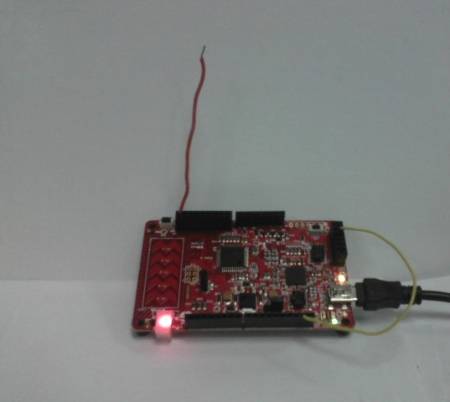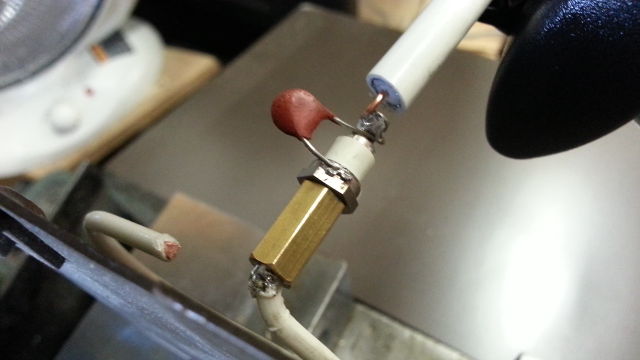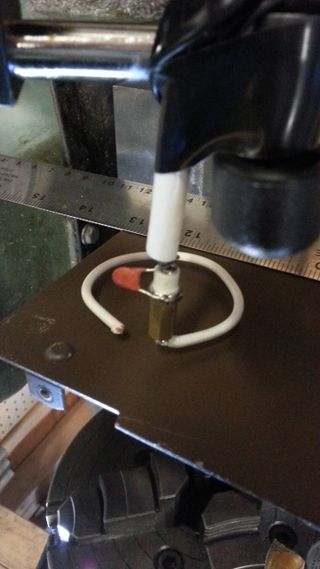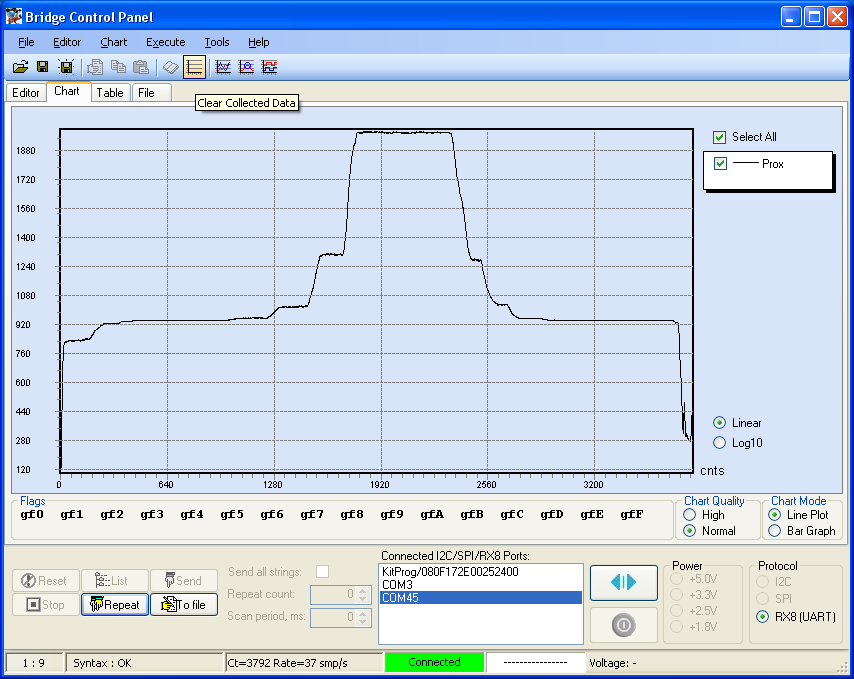PSoC Torch Height Sensing: Difference between revisions
m (→ChuckH testing) |
|||
| Line 11: | Line 11: | ||
'''21 July 2013''' | '''21 July 2013''' | ||
We would like to place the circuit board in a shielded enclosure a foot or so from the torch itself, especially in the case of plasma torch application. Therefore I tried connecting the sensing electrode through about 2ft of coaxial cable. I used "CATV" coax (used with cable TV and antennas) because it is a foam core, low-capacitance cable. The PSoC chip supports "driven shield" so I used it. There are two subtypes of driven shield, "precharge by Vref buffer" and "precharge by IO buffer", it is not yet clear which is most appropriate. | We would like to place the circuit board in a shielded enclosure a foot or so from the torch itself, especially in the case of plasma torch application. Therefore I tried connecting the sensing electrode through about 2ft of coaxial cable. I used RG6/U type "CATV" coax (used with cable TV and antennas) because it is a foam core, low-capacitance cable, nominally ~16pf/ft. The PSoC chip supports "driven shield" so I used it. There are two subtypes of driven shield, "precharge by Vref buffer" and "precharge by IO buffer", it is not yet clear which is most appropriate. | ||
To help protect the CapSense input pin from noise spikes (specifically a concern about plasma torch RF noise damaging the chip) I placed a 12pf capacitor in series with the sensing electrode. I made a ring shape out of insulated 14AWG solid house wiring: | To help protect the CapSense input pin from noise spikes (specifically a concern about plasma torch RF noise damaging the chip) I placed a 12pf capacitor in series with the sensing electrode. I made a ring shape out of insulated 14AWG solid house wiring: | ||
Revision as of 05:10, 24 July 2013
Cypress PSoC4 Pioneer Board for Capacitive Torch Height Sensing
We are evaluating whether this board can provide operating height sensing for an oxyfuel torch and initial height sensing for a plasma torch. This is an important funtion required in the CNC Torch Table.
The PSoc4 ("Programmable System on a Chip") is a small ARM microcontroller with flexible peripherals. One of the peripheral functions is Cypress' "CapSense" capacitive touch sensing. A relevant demo project, using the Arduino-form-factor "Pioneer" board is here.
ChuckH testing
21 July 2013
We would like to place the circuit board in a shielded enclosure a foot or so from the torch itself, especially in the case of plasma torch application. Therefore I tried connecting the sensing electrode through about 2ft of coaxial cable. I used RG6/U type "CATV" coax (used with cable TV and antennas) because it is a foam core, low-capacitance cable, nominally ~16pf/ft. The PSoC chip supports "driven shield" so I used it. There are two subtypes of driven shield, "precharge by Vref buffer" and "precharge by IO buffer", it is not yet clear which is most appropriate.
To help protect the CapSense input pin from noise spikes (specifically a concern about plasma torch RF noise damaging the chip) I placed a 12pf capacitor in series with the sensing electrode. I made a ring shape out of insulated 14AWG solid house wiring:
Initial tests show plenty of signal (the steps in this staircase are 0.050 inch movements):
However the following technical issues need to be explored:
- . Is the sensor adequately protected against plasma noise damage?
- . How should the system reject long-term (time, temperature, etc.) drift?
- . Despite using shielded (coax), there is still some sensitivity to objects near the cable and circuit board.
- . How will the system respond to sensing near the edge of a workpiece (where only half of the ring is over the work)? An informal check showed significant signal loss.
In addition we have to develop code which uses the distance sensing information to control a z-axis motor. This could run on the RAMPS Arduino, or it would be possible to execute this code on the PSoC4 Pioneer board; it has a pretty capable microprocessor. For that matter, the PSoC could also handle arc voltage sensing for a plasma torch.



